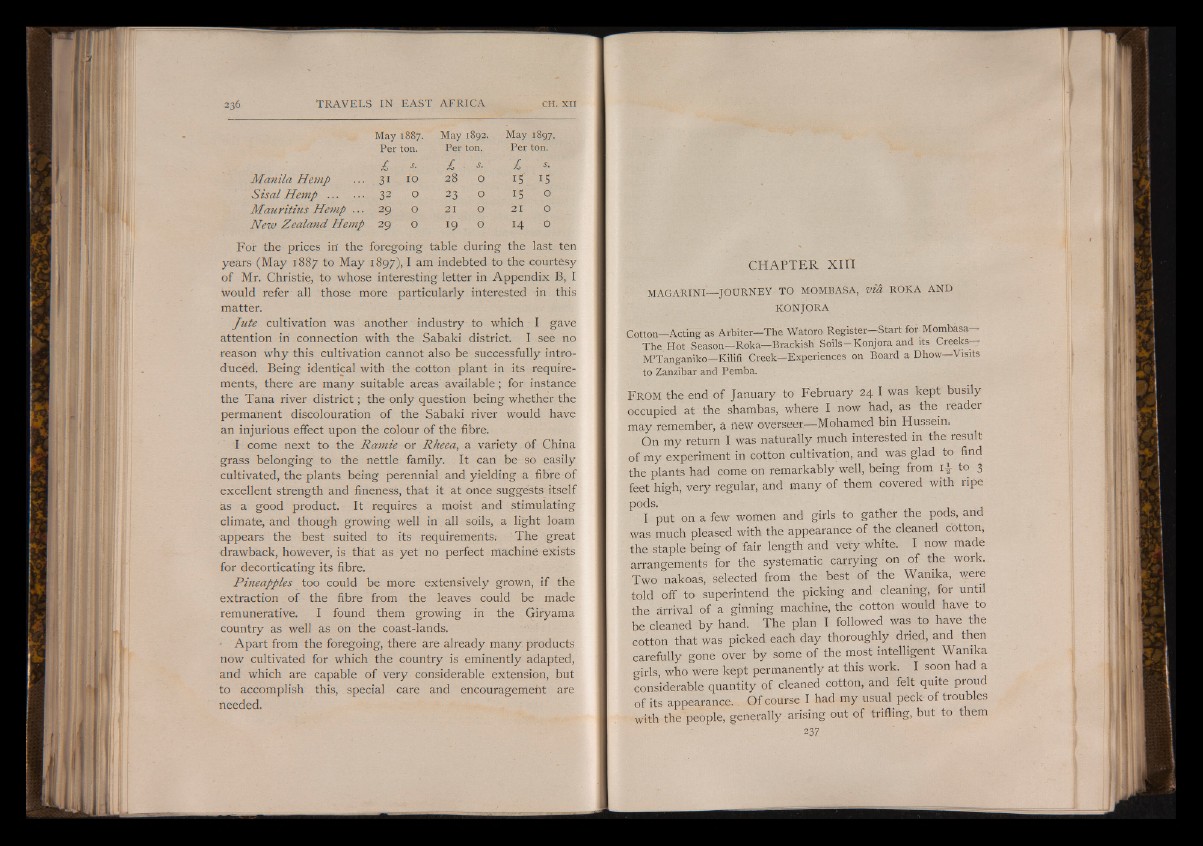
May 1887. May 189,2. May 1897
Per ton. Per ton. Per ton.
£ £ s. £ S.
Manila Hemp 31 10 28 0 15 15
Sisal Hemp ........... 32 0 23 • 'i i s 0
Mauritius Hemp ... 29 0 21 O 21 0
New Zealand Hemp 29 0 19 O 14 0
For the prices in the foregoing table during the last ten
years (May 1887 to May 1897), I am indebted to the courtesy
of Mr. Christie, to whose interesting letter in Appendix B, I
would refer all those more particularly interested in this
matter.
Jute cultivation was another industry to which I gave
attention in connection with the Sabaki district. I see no
reason why this cultivation cannot also be successfully introduced.
Being identical with the cotton plant in its requirements,
there are many suitable areas available; for instance
the Tana river district; the only question being whether the
permanent discolouration of the Sabaki river would have
an injurious effect upon the colour of the fibre.
I come next to the Ramie or Rheea, a variety of China
grass belonging to the nettle family. It can be so easily
cultivated, the plants being perennial and yielding a fibre of
excellent strength and fineness, that it at once suggests itself
as a good product. It requires a moist and stimulating
climate, and though growing well in all soils, a light loam
appears the best suited to its requirements; The great
drawback, however, is that as yet no perfect machine exists
for decorticating its fibre.
Pineapples too could be more extensively grown, if the
extraction of the fibre from the leaves could be made
remunerative. I found them growing in the Giryama
country as well as on the coast-lands.
■ Apart from the foregoing, there are already many products
now cultivated for which the country is eminently adapted,
and which are capable of very considerable extension, but
to accomplish this, special care and encouragement are
needed.
CH APTER XIII
MAGARINI—JOURNEY TO MOMBASA, via ROKA AND
KONJORA
Cotton— Acting as Arbiter— The Watoro Register— Start for Mombasa—
The Hot Season-Roka— Brackish Soils-Konjora and its Creeks—
M’Tanganiko— Kilifi C r e e k — Experiences on Board a Dhow—Visits
to Zanzibar and Pemba.
FROM the end of January to February 24 I was kept busily
occupied at the shambas, where I now had, as the reader
may remember, a new overseer— Mohamed bin Hussein.
On my return I was naturally much interested in the result
of my experiment in cotton cultivation, and was glad to find
the plants had come on remarkably well, being from to 3
feet high, very regular, and many of them covered with ripe
pods.
I put on a few women and girls to gather the pods, and
was much pleased with the appearance of the cleaned cotton,
the staple being of fair length and very white. I now made
arrangements for the systematic carrying on of the work.
Two nakoas, selected from the best of the Wanika, were
told off to superintend the picking and cleaning, for until
the arrival of a ginning machine, the cotton would have to
be cleaned by hand. The plan I followed was to have the
cotton that was picked each day thoroughly dried, and then
carefully gone over by some of the most intelligent Wanika
girls who were kept permanently at this work. I soon had a
considerable quantity of cleaned cotton, and felt quite proud
of its appearance.. Of course I had my usual peck of troubles
with the people, generally arising out of trifling, but to them
?37